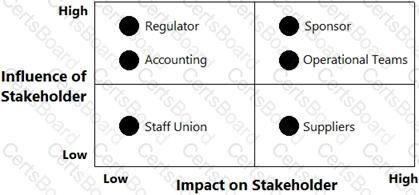A business analyst (BA) is currently verifying the accuracy and consistency of information obtained from the stakeholders. The BA needs to identify additional information. What should the BA do next?
A project aiming at improving an organization's Net Promoter Score is nearing completion. The business analyst (BA) and stakeholders are evaluating ways to measure the performance of the solution. Which technique may be employed?
A business analyst (BA) is working on a set of tasks to establish a governance process for the project. The BA intends to identify who has authority and responsibility to propose changes, who should be involved in the change discussions, and how changes will be documented and communicated. Which of the following are the inputs that would help the BA complete the task?
A business analyst (BA) has documented the components of an information technology (IT) library, in preparation for establishing a consolidated catalogue of IT services. When interviewed, several of the IT managers indicated they already have a catalogue, and have no additional information to provide. What activity is necessary to support the project?
A one-location restaurant has been a huge success and the owner wants to expand into more markets. The owner wants to ensure that the quality of the food and pleasing atmosphere is maintained without introducing new variables. Working with the key members of the organization, the owner determines that training and standard processes must be defined. The owner engages a business analyst (BA) to create training materials and operating procedures based on the existing processes at the original restaurant. During this documentation, the BA identifies some opportunities for improvement. How must the BA proceed?
A business analyst (BA) has decided to use a passive/unnoticeable job shadowing elicitation approach. What is an advantage of using this technique?
A business analyst (BA) is eliciting requirements for a pharmaceutical distribution company with an expansion plan across many states, each with their own tools and methods. To make the requirements as re-usable as possible, what should the BA do?
A business analyst (BA) is informing stakeholders about the importance of quality when eliciting requirements. What characteristic describes a quality requirement?
A company is embarking on a software project in a heavily regulated domain. The client expects large upfront planning and detailed documentation for the project. The recommended approach for the project will be:
A business analyst (BA) needs approval for the requirements which were elicited, collated, and verified by a peer. The BA needs to understand the approval process and appropriatestakeholders who have the authority to approve the requirements. Which of the following artifacts contains this information?
A business analyst (BA) creates several use case scenarios to specify the requirements for a system. When the beta version of the system is released, there are problems because several important pieces of information are missing. What should the BA have done to avoid this situation?
A business analyst (BA) is structuring requirements to ensure they are cohesive and tell the full story. Which of the following requirements is consistent with a stakeholder's need: “As a Product Manager, I want to review my general insurance sales performance so I track my sales performance against my annual target”?
A large online retailer is introducing new technology to upgrade its aging ordering process. The business analyst (BA) has drawn a stakeholder matrix showing information on how to engage with the stakeholders throughout the project.

Using the stakeholder matrix as a guide, how should the BA engage the suppliers?
A business analyst (BA) elicits requirements from end users for a new application and then documents a set of use cases and use case scenarios. What should the BA do next?
A business analyst (BA) has set up a number of elicitation workshops with key subject matter experts (SMEs) on a new project. All SMEs have accepted the workshop invitations except forthe legal SME, who has not responded to any invitations. The first workshop is scheduled for next week, and the BA has tried unsuccessfully to reach the legal SME by phone. How should the BA proceed?


